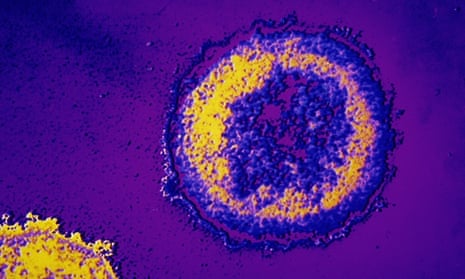Researchers hope an oral HIV test will be approved by Australia’s drug regulator for home use, saying it would curb infection rates by diagnosing people earlier so they can take steps to prevent spreading the virus.
HIV rates in Australia are at a 15-year high, increasing 20% in the last five years, with 27,000 people across the country living with the virus.
Despite research released last year finding 88% of the country’s new infections occurred in gay men, less than two-thirds of gay men were being tested for HIV annually.
To increase testing and early diagnosis among this group, researchers led by the Albion Centre, a sexual health clinic in Sydney, gave an oral HIV test to 1,006 men who have sex with men, and other people considered at high-risk of contracting the virus, to take home.
The two-step test involves using a swab in the mouth on the upper and lower gum for about five seconds. The swab is then inserted into a tube of liquid. It takes about 20 minutes to produce a result.
They are read similarly to a pregnancy test, with two lines appearing for a “reactive” result, which means HIV antibodies were detected and the user should see their doctor for a standard HIV test.
“The key point about the test is that they are screening tests, not diagnostic tests, so part of proper training in their use would be that any ‘reactive’ result that you get may not actually be true and you should definitely go to a doctor and follow-up with a blood test,” study leader associate professor Derek Chan said.
“We also know in the general population you’re very likely to be negative, but if you’re in a high-risk group with a recent risk event, you may record a negative result which does not necessarily mean you’re OK.”
The test correctly detected people with HIV in 84.6% of study participants who recorded a reactive result, while it correctly delivered a non-reactive result in 99.8% of those who tested negative.
Overall, 11 study participants were detected to have HIV through the oral test which was also confirmed with a standard blood test. Two participants tested negative when they were in fact HIV-positive because they had early infections not detected by the oral test. There was one false positive result due to reader error.
The results were published in the Medical Journal of Australia, with the test now before the Therapeutic Goods Administration, which is considering its approval for home use.
The United States licensed the oral test for home use in 2012. While a rapid HIV blood test is already available in Australia, it is only available in clinics.
Living Positive Australia executive officer, Brent Allan, said in order to reduce HIV transmission, testing needed to be made easier to access.
Along with condom use, early treatment of infections is considered essential to preventing HIV’s spread, with those taking antiretroviral treatments reducing their chance of transmitting the virus to others during unprotected sex by up to 96%.
“This is also a good option for someone who may be very closeted about their sexuality and who may not feel comfortable going to their doctor initially,” Allan said.
“While the gold standard would be to be tested at a doctor so that you have someone there available for you to talk to in case of a positive result, I think it is also important to capitalise on new medical technology, so it would be ideal if online support services were provided with the test, or the number for a telephone support service.”
The test would also be useful for young travellers returning from overseas where rates of HIV among the general population may be much higher than in Australia, Allan said.
- This article was amended on 12 March 2015 to correct the number of people who were correctly assessed as having HIV by the test. It was 84.6%, not 98.5%.

Comments (…)
Sign in or create your Guardian account to join the discussion